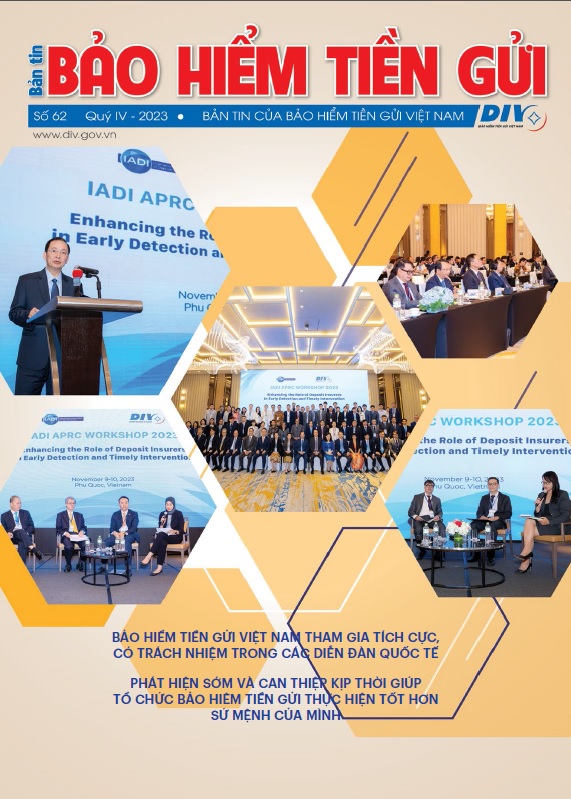International experiences indicate that the DI coverage limit not only decides the amount of compensated money which depositors get back upon compensation obligations arise but also affects the behaviors of depositors when reimbursement obligation has not arisen yet. A reasonable DI coverage limit helps depositors feel more secure when depositing at banks, without worrying or withdrawing money from banks, resulting in bank runs when there are fluctuations in the finance and banking system. Therefore, it will help to restrict the contagious effects of the banking system in particular and the whole economy in general.
The International Association of Deposit Insurers (IADI) recommends that a suitable DI coverage limit should ensure that a considerable ratio of deposits is not protected. People with considerable deposits are often considered as having knowledge, awareness, and information about finance and banking. Therefore, they are able, and at the same time, are responsible for researching and selecting credible credit institutions which operate soundly to preserve capital and make deposits profitable.
According to the Deposit Insurance of Vietnam (DIV), the current DI coverage limit of 125 million dong can fully protect 91% of depositors in the banking system. Compared with recommendations by the IADI, the DI coverage limit of Vietnam is suitable. Meanwhile, 9% of the remaining depositors have deposit balances at credit institutions higher than the DI coverage limit as mentioned above. They are still protected indirectly by the DIV through examination, supervision, participation in special control, support in credit institution recovery, etc.; at the same time, in the event of failure of credit institutions, the DIV will reimburse depositors at the maximum amount equivalent to DI coverage limit of 125 million dongs. The amount of insured deposits (including principal and interest) exceeds the coverage limit will be resolved in asset liquidation of insured institutions as legally regulated.
For coverage limit to bring into full play its role as a policy tool
Therefore, it can be said that not until the deposit insurance organization makes reimbursement to depositors that DI coverage limit comes into play. This is a policy tool that can be regulated, thereby realizing the objectives of the DI policy, which is to contribute to maintaining the stability of credit institutions, ensuring the safety and sound development of banking operations.
The roles of maintaining market principles of DI coverage limit are based on the following pillars:
Firstly, in general, depositors and the public have basic knowledge of finance and banking.
Secondly, depositors are fully informed and aware of the nature and significance of the DI coverage limit as well as the DI coverage limit in each period.
Thirdly, depositors have easy access to information about the performance of deposit-taking credit institutions and the ability to tell and recognize credit institutions that operate safely and effectively.
As such, depositors can be proactive in making deposits, with cautious considerations based on information and knowledge to select suitable deposit-taking institutions, promoting sound competition among credit institutions instead of paying attention to only interest rates or other preferences.
During this process, the DI organization plays an important role since it is the focal point for policy implementation and, at the same time, the organization which directly protects the rights of depositors. The DIV can actively participate in 2 of the 3 pillars mentioned above. Firstly, it can communicate broadly to the public on the current DI coverage limit as well as the purposes and significance of the coverage limit and the basis to identify the coverage limit. Therefore, depositors will be aware of how their rights are protected before relying on policy support or support from authorities.
Besides, the deposit insurer can participate in public promotion awareness programs to enhance the awareness and perceptions of depositors about finance and banking in general. In many countries, besides central banks, supervisory and financial consumer protection agencies, deposit insurance often plays a fundamental role spreading in public financial knowledge.
In making it possible for depositors to have easy access to updated information about the operations of credit institutions, it is necessary to promote accountability for disclosure transparency. Today, many banks have been listed on the stock exchange and fulfilled the obligation of disclosure as legally stipulated. However, not only banks but also small-size credit institutions such as People's Credit Funds should also bring into full play its accountability of disclosure transparency to depositors in general and the funds' members in particular, thereby continuously improving operational effectiveness, optimizing resources and developing sustainably.



























